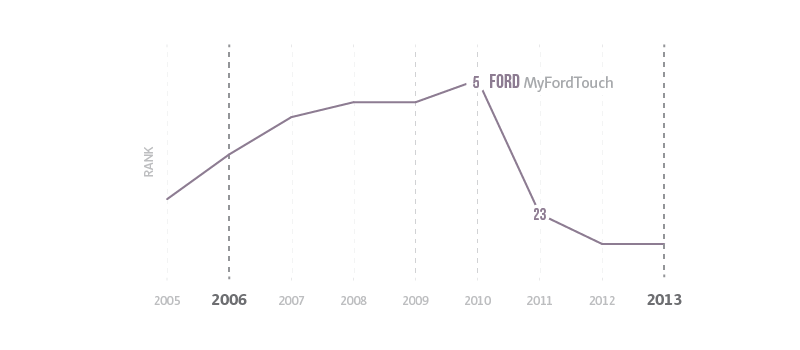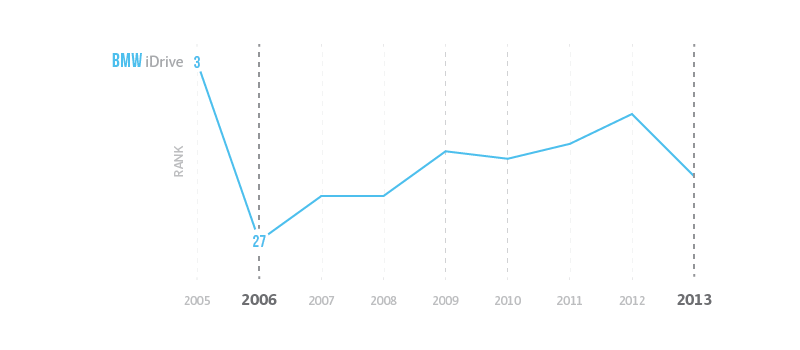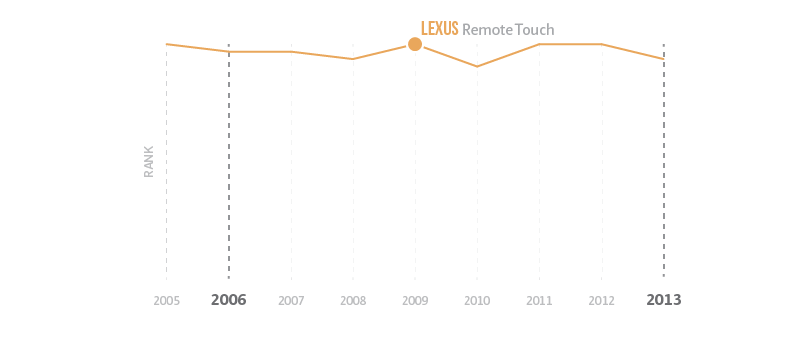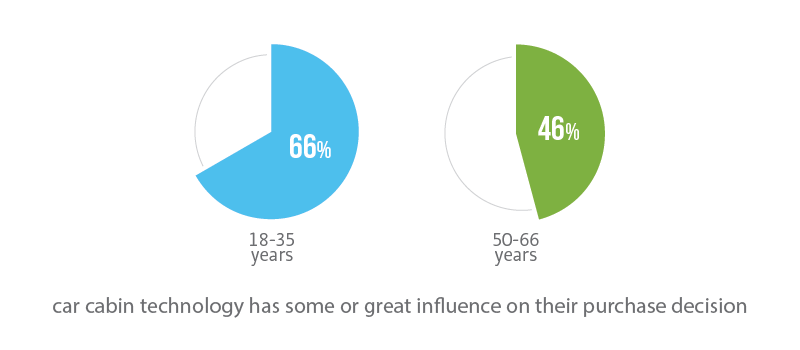The Increasing Importance of User Experience
6 min read
Last month J.D. Power & Associates released this year’s results to their annual Initial Quality Study (IQS). What caught our attention this year is two-thirds of all problems reported were design-related. In fact, over the past decade there has been a big shift in how J.D. Power has been assessing brand quality. This shift tells a compelling story as to how the importance of user experience is increasing.
Changing Criteria
The shift in brand quality measurement started in 2006 when J.D. Power changed their IQS criteria to include design flaws & usability of the car’s cabin technology. These criteria may have been added because three of the leading German auto manufacturers (BMW, Audi & Mercedes) had integrated new technology systems into their vehicles in 2002 and 2003. Their systems centralized many of the vehicle functions, however the vehicle owners were having difficulties using them. J.D. Power wanted to introduce new criteria in order to get a clearer picture of the problems owners were experiencing.
“It is not technology per se that generates new problems, but rather its integration and execution.”
Vehicle owners were asking for this technology in their vehicles, however they were frustrated with how it was done. Fast-forward to 2013, and J.D. Power has decided to update their criteria again. They are continuing to see design flaws as an increasing problem and redefined their study to accurately measure problems related to technologies and features now being offered.
Brand Quality Being Affected
The annual IQS rankings really show the impact these design flaws have on the perception of the brand’s quality. What’s interesting is that these systems are not available on all models, but they impact the company’s entire brand. Let’s take a closer look at Ford, BMW and Lexus to see how they have done, and what impact the new technology is having on them.
Ford
In 2011 when Ford released its MyFord Touch system, its ranking plummeted. Before they released this system, Ford had been focusing on their manufacturing quality and slowly increasing their brand ranking. However, after the release of their MyFord Touch system their perceived brand quality dropped significantly (see below).
 source: J.D. Power & Associates Initial Quality Study (IQS)
source: J.D. Power & Associates Initial Quality Study (IQS)
The decline that we see in 2011 wasn’t caused by problems with the manufacturing of the vehicle. In fact, according an article in the NY Times, the decline has nothing to do with their manufacturing at all. It was due to the MyFord Touch system and the frustration vehicle owners were experiencing. Consumer Reports found that 30% of owners surveyed said the system was highly influential in their purchase decision, however almost two-thirds of them found it complicated to use.
BMW
All three German manufacturers experienced a drop in their rankings when the survey was updated in 2006, however the most severe drop was seen by BMW. Their iDrive system has received heavy criticism for integrating too many features and making them difficult to find. The problems owners experienced with their system are reflected in their quality rankings (see below).
 source: J.D. Power & Associates Initial Quality Study (IQS)
source: J.D. Power & Associates Initial Quality Study (IQS)
According to CNET reviews, “BMW drivers identified the ‘difficult to use’ and ‘poorly located’ front audio and entertainment system as their number one complaint” in 2006. Since then, their rankings show they were slowly making improvements and their ranking reached its highest in 2012 at 10th. Then they had another drop (down to 18th) this year presumably due to the enhanced criteria that J.D. Power is now using to measure design-related problems.
Lexus
In contrast to these other two examples, Lexus has consistently been ranked in the top five. Even when they introduced their RemoteTouch system in 2010, the small number of complaints with the design caused only a slight drop in their ranking, down to 4th (see below). According to CNET; “As a controller system Remote Touch is wonderfully simple to use.”
 source: J.D. Power & Associates Initial Quality Study (IQS)
source: J.D. Power & Associates Initial Quality Study (IQS)
This example shows us that introducing technology into the vehicle doesn’t necessarily equate to a drop in the perceived quality of the product. If it is done right, it can meet customer expectations as well as enhance the brand perception.
Technology Influences the Purchase Decision
Looking at these results, one might conclude that the easiest solution would be to not put the technology in the vehicles at all. Unfortunately the technology cannot be avoided, especially in the younger generations. According to research by Harris Interactive, technology has a substantial influence on the purchase decision of a vehicle (see below).
 source: Harris Interactive
source: Harris Interactive
Advanced technology is becoming a more important factor when customers are deciding which vehicle to purchase. The technology offered in a vehicle has risen to the #8 spot on top 10 list (up two spots in the past three years) of reasons buyers choose a specific vehicle model.
Additionally, design-related problems don’t just pertain to the integrated technology systems in the vehicle. Other design-related problems also come up in the study, and these can be very difficult to remedy. JD Power explains that in the first 90 days only 9% of owners take their vehicles to the dealership for design-related problems, and only 13% of those are actually fixed. In contrast, 28% of owners with manufacturer defects or malfunctions take their vehicle back to the dealership, and 42% of the time the dealer fixes this problem. So while design-related problems make up two-thirds of the problems reported, their likeliness of being fixed is much lower. This means the owner is likely going to have to accept those problems for the life of the vehicle.
Importance of User Experience
Valuable lessons can be learned from what the auto industry is experiencing. Consumers are demanding more advanced technology for added convenience and features, but how this technology is integrated is important. Consumer expectations continue to grow for technology that will make thier lives easier and more comfortable. As this continues, there is an increasing need for user experience (UX) to be a part of planning, design and development processes. Bringing UX professionals into the process early helps to identify and resolve usability problems before they are built into the product.
Utilizing a user-centered approach for designing products and services focuses in on solutions that will be desirable to target users. This exposes the user’s goals and the environmental factors affecting them. Armed with this knowledge companies can design useful products and in return can benefit from increases in sales and customer loyalty.






